MIKE SAFFER OUTLAND TROPHY CANDIDATEOutland Trophy candidate Mike Saffer is a powerful presence on the UCLA offenseBy Kim Goss Published: Winter 2002 In the last 20 years, UCLA has finished in Associated Press' Top Ten ranking seven times, the most of any Pac-10 school. Also in that time it won nine of its 13 bowl games, a statistic that has been exceeded by only six other schools in the country. It takes an exceptional athlete to play at UCLA, and it takes a superior one to start all four years. Offensive right tackle Mike Saffer is such an athlete. A candidate for the prestigious Outland Trophy, awarded every year to the best lineman in the country, Saffer is part of a veteran offensive line that many pre-season polls rated among the best in the country. The UCLA coaching staff considers Saffer an aggressive athlete who is equally adept at both run- and pass blocking. Leading the praise is Offensive Line Coach Mark Weber. “Mike is one of the hardest-working athletes I've ever had a chance to coach,” says Weber. “He is a real effort guy, on and off the field. Mike will certainly get a chance to play in the NFL.” Big-Time Basics If the expression “like father, like son,” ever applied to an athlete, if would be appropriate for Mike. His father was a guard for John Wooden's 1967 NCAA championship basketball team, and his two older brothers, Jonathan and Jeffrey, played professional baseball. When asked why he chose football, Saffer replied, “In my family we played all the sports when we were young, and we stuck with the sport that we were best at. It was obvious that my talents were on the football field, and my brothers decided that baseball was the path for them.” Saffer attended Sabino High School in Tucson, Arizona. At the time, the team was coached by BFS clinician Jeff Scurran. In Saffer’s three years as starter, his teams rarely tasted defeat: they won 35 games and went to the state semifinals twice and the championship game once. As for Saffer's performance, during that period he allowed only one sack, a fact that Scurran says is especially remarkable because he played open side tackle. “Open side tackle is one of the most difficult and important linemen positions to play in a passing attack because they protect the quarterback's blind side. That is why they are the highest-paid offensive linemen in the NFL.” If there is one aspect of Saffer's character that impresses Scurran the most, it is his maturity. “Mike was always real easy to coach because he understood why some people were successful and why others were not. One of the reasons was that Saffer was around so much athletic success in his family.” Scurran also says Saffer had an advantage in that he worked hard in the weight room on the basics. “Mike never knew anything other than the Bigger Faster Stronger program. He could do reps in the power clean with 300 pounds and the squat with 600 pounds, and at 275 pounds bodyweight he was the first really big man I coached who broke 50 seconds in the BFS dot drill.” In reflecting on his high school experience, Saffer said it was a great experience and that he felt prepared for college. “Coach Scurran runs a top-notch program,” says Saffer. “I was probably more prepared coming into college than a lot of freshmen because of the way our program was run. Coach Scurran runs his high school program like a college program, so his athletes are prepared, and I think that's why his athletes have had so much success.” Saffer's success in high school earned him USA Today first-team All-American honors, among others, and he had entertained scholarship offers from Nebraska, Washington and Arizona State University. UCLA was the obvious choice. “A lot of my decision had to do with my family. Many of my family members graduated from UCLA and my dad played basketball here. Also, of the schools that I was deciding among, UCLA was the closest to home, and that was important to me.” When he began attending UCLA, Saffer continued his strong work ethic in the weight room, as evidenced by a 370 power clean and a 420 bench press. He also refined his blocking technique with the help of Coach Weber. “The number-one skill that Coach Weber worked on with me, and with most of the line, was our finishing blocks. That emphasis has made me a much better player, and a better leader-I'm going snap-to-whistle every play.” In his first year in a Bruins uniform, Saffer impressed the coaching staff enough to trust him to start in seven games. Saffer was on the field for at least 70 plays in games against Ohio State, Arizona, Oregon and Oregon State. The following year he started all 12 games, missing just one offensive snap the entire season. Again a workhouse, he took at least 80 snaps in games against Alabama, California, Fresno State and Arizona State. By 2001 Saffer had become a leader on the offensive line, and he stepped up his play another notch to earn second-team All-Pac-10 conference honors. In the game against Washington in which DeShaun Foster broke the single-game rushing record with 301 yards, Saffer graded out at 97 percent. For the year, he averaged at least an 88 percent grade in eight games and racked up 46 KO blocks. Unquestionably, Saffer had become the best bodyguard a quarterback could hope for. Entering the 2002 season as an Outland Trophy candidate, Saffer and his three other returning starters on the offensive line expected to enjoy a winning season and see post-season action. What Saffer didn't expect to see was his photo on the cover of the “UCLA Football Media Guide,” a rare occurrence for a lineman. “I would say I was surprised, but at the same time I felt that I had put in the hard work and I've become a leader on this team -- and I didn't give them any reason not to put me on the cover,” he quips. “I feel like I've made those decisions easier for our marketing department because I've done the best I could here.” Midway through the season the team has had only one conference loss and has become an offensive powerhouse, averaging 33.5 points per game. Their biggest upset was on their opening game against Colorado State, which was ranked 19th going into Pasadena and had the advantage of having already played two games. The Bruins defeated the Rams 30-19 in a thrilling match that saw the Rams ahead going into the fourth quarter. Saffer has had great memories so far playing on the 2002 UCLA team. “Other than the fact that there's a lot of experience on this line, one of the great things about this offensive line is that everybody on the line enjoys hanging out together, off the field as well as on the field,” says Saffer. “This really promotes team unity and even helps us on the field because we're able to communicate better -- it seems like we know what each other is thinking before we're thinking it. This is important, because with the offensive line you have to play as a unit.” Asked what advice he would give young offensive linemen, Saffer replies, “You need to make sure you know your sets, and know what you're supposed to do on every play. But I would say the most important aspect of being a lineman is to be a technician-if your technique isn't good then you've got nothing.” As for which college a high school athlete should aspire to, Saffer believes an athlete can't go wrong with UCLA. “UCLA has the perfect combination of athletics and academia. It's easy to get lost in athletics, but they've got such a great academic program you can really involve yourself in those classes as well. Also, our fans are loyal and support us with everything they've got.” Among the people Saffer wants to thank for helping him achieve his goals are Jerry Holmes, who coached Saffer when he played youth basketball, and Glenn Howell. “Glenn was a very close friend of the family who you could say tutored me in life as well as in athletics since I was in high school. I worked out with him all the time, and he's been a tremendous influence on my life.” With his standout abilities and attitude, Mike Saffer has earned his place in the UCLA history boo |
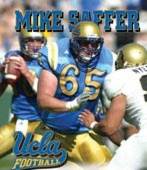 |
|
Outland Trophy candidate Mike Saffer is a powerful presence on the UCLA offense |
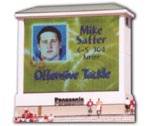 |
|
|
 |
|
|
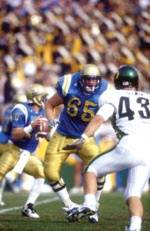 |
|
Saffer plays open side tackle wich is one of the most difficult and important linemen postions to play in a passing attack because they protect the quarterback's blind side. That is why the are the highest-paid offensive linemen in the NFL. |
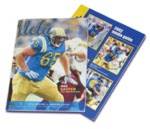 |
|
Saffer was featured on the cover of a UCLA program and the 2002 media guide. |
 |
|
Coach Scurran coaches as Saffer finishes a deadlilft at Sabino High School AZ. |
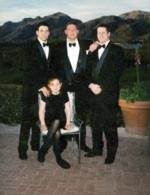 |
|
The Saffer family with brothers Jonathan, Jeffery, and sister Danielle. |
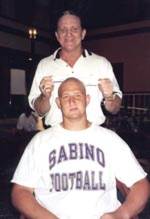 |
|
Saffer with dad Don |
 |
|
Saffer with mom Susan. |
 |
|
|